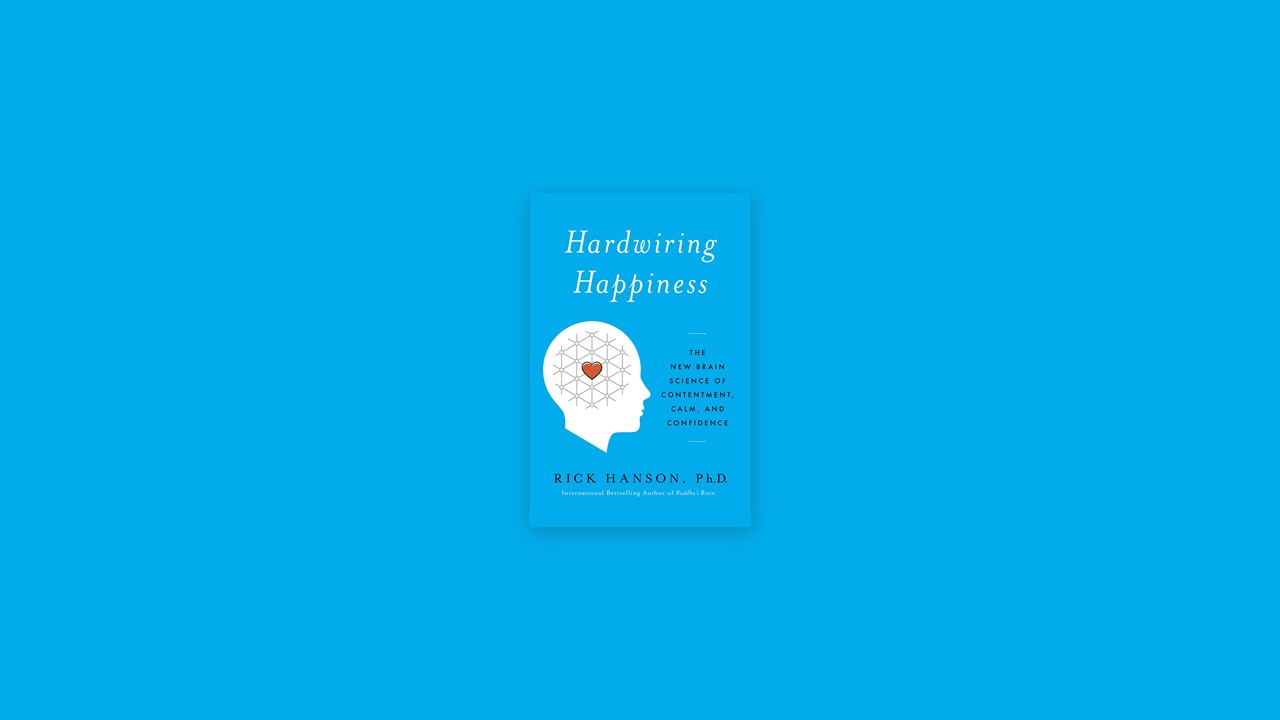Growing Good
A person’s inner strengths include peacefulness, contentment, and love, as well as resilience, confidence, determination, and insight. These strengths help you cope with the hard things in life, recover from stress, heal old pain, maintain your well-being, get things done at home and work, and be patient and caring toward others.
Most of your inner strengths are developed over time. This book is about growing inner strengths through positive experiences, which is hardwiring happiness.
The best way to develop greater happiness and other inner strengths is to have experiences of them, and then help these good mental states become good neural traits. This is taking in the good: activating a positive experience and installing it in your brain.
Velcro for the Bad
To survive and pass on their genes, our ancestors needed to be especially aware of dangers, losses, and conflicts. Consequently, the brain evolved a negativity bias that looks for bad news, reacts intensely to it, and quickly stores the experience in neural structure. We can still be happy, but this bias creates an ongoing vulnerability to stress, anxiety, disappointment, and hurt.
A key aspect of the negativity bias is the special power of fear. We routinely overestimate threats and underestimate opportunities and resources. At the same time, negative experiences sensitize the brain to the negative, making it easier to have even more negative experiences in a vicious circle.
Inner strengths such as happiness and resilience come mainly from positive experiences. But unless we pay mindful, sustained attention to them, most positive experiences flow through our brains like water through a sieve. They’re momentarily pleasant but leave little lasting value in terms of changing neural structure. The brain is like Velcro for negative experiences but Teflon for positive ones.
While the negativity bias is good for survival in harsh conditions, it’s lousy for quality of life, fulfilling relationships, personal growth, and long-term health. It makes us over-learn from bad experiences and under-learn from good ones.
The best way to compensate for the negativity bias is to regularly take in the good.
HEAL Yourself
Taking in the good is the deliberate internalization of positive experiences in implicit memory. It involves four simple steps (the fourth one is optional). (1) Have a positive experience. (2) Enrich it. (3) Absorb it. (4) Link positive and negative material. The first letter of each step forms the acronym HEAL. Step 1 activates a positive experience, and steps 2 to 4 install it in your brain.
It’s natural to take in the good. We all know its essence: have a positive experience and then really enjoy it. But as with any other skill, you can get better at it through both learning and practice.
Most positive experiences are relatively brief and mild. But taking in half a dozen of them a day, half a minute or less at a time, will add up to something big for you.
You can take in good experiences both in the flow of daily life and during special times such as at a meal or just before bed.
Taking in the good involves being a good friend to yourself. If this is hard for you, as it is for many people, you can deliberately create and take in experiences of being on your own side.
Some experiences are particularly valuable to take in. When your brain’s avoiding harms system is threatened, you need key experiences that are directly related to it, such as a sense of protection or strength. The same is true for the approaching and attaching systems. You can use the HEAL steps to look for and take in the experiences that would really help you these days.
Drawing on the hidden power of seemingly ordinary experiences, this deceptively simple practice builds resilience, heals distress and dysfunction, improves relationships, promotes physical health, and grows a durable happiness
Take Notice
There are two ways to do step 1 (Have) of taking in the good: notice a positive experience that is already present or create one.
You can notice a positive experience in either the foreground or background of your awareness. Try to be more aware of the experiences hovering in the background, which will give you more good things to take in.
Be aware of the different parts of your experience, including thoughts, sense perceptions, emotions, desires, and actions. Each of these could be good to take in.
Thoughts include inner speech as well as images, expectations, perspectives, plans, and memories. Useful sensory experiences include pleasure, relaxation, vitality, and strength. Emotions consist of changeable feelings and enduring moods; repeatedly taking in certain feelings could shift a related mood. Desires include your hopes, intentions, morals, and wants. Actions include your behaviors as well as your inclinations and skills.
Your brain has separate systems for liking and wanting. Consequently, it is possible to like something without wanting it. If you let yourself have positive experiences without trying to hold on to them, you’ll enjoy them more and won’t get carried away by the drivenness and pressure of wanting them.
Noticing good experiences gives you many opportunities to take in the good each day. Even noticing your own awareness is an opportunity for a good experience, since awareness is inherently peaceful and never tainted or harmed by what passes through it.
Creating Positive Experiences
Being able to self-activate positive experiences—to call up inner strengths at will—is fundamental to coping, well-being, and everyday effectiveness. With practice, these experiences and strengths will increasingly activate on their own.
In order to turn the idea of a good fact into a more embodied experience, tune in to your body, soften and open, and think about aspects of the fact that naturally generate positive emotions, sensations, desires, or actions.
Good facts can be found in your current setting as well as in recent events, ongoing conditions, your personal qualities, the past, and the lives of others. You can also create good facts. Any good fact is the potential basis for a good experience.
Additional ways to create positive experiences include imagining the future, sharing good experiences with others, finding the good in the bad, being caring, imagining good facts (both ones that could be true and ones that couldn’t be), and directly evoking a positive experience.
Sometimes you just can’t have a positive experience. But most of the time, it is possible to notice or create one. This fact is another source of good experiences: seeing life as opportunity.
Brain Building
The second and third steps of HEAL are to Enrich and Absorb a positive experience in order to install it in your brain.
Five major factors enrich an experience and heighten its conversion into neural structure: duration, intensity, multimodality, novelty, and personal relevance.
You can absorb the experience by visualizing it sinking into you, by sensing it coming into your body, and by letting yourself be changed by it.
Routinely giving yourself a basic sense of peace, contentment, and love is a wonderful way to come home to the responsive mode and deepen its neural traces.
Flowers Pulling Weeds
Unpleasant experiences are part of life, and sometimes have value. But due to the negativity bias, it’s easy for unpleasant experiences to get stored in your brain as negative material, which has negative consequences for you and often others.
When negative material is activated, typically from implicit memory stores, it is not retrieved as a unit from storage but rather is reconstructed in a dynamic process. Once it comes into consciousness, it starts associating with whatever else is present in awareness. Then, when it’s no longer activated, it gets reconsolidated back into memory, also in a dynamic process.
The dynamic nature of memory reconstruction and reconsolidation gives you two good methods for changing negative material. First, when you are aware of prominently positive material alongside the negative, what’s positive can soothe, compensate for, and sometimes eventually overwrite the negative. Second, during the “window of reconsolidation,” if you bring to mind a neutral trigger associated with the negative material while feeling only neutral or positive, this can disrupt the reconsolidation process and gradually erase the association between the neutral trigger and the negative material.
To do the fourth step of HEAL—Linking positive and negative material—you need to be able to hold both positive and negative in awareness while keeping the positive more prominent and not getting hijacked by the negative.
Once you have identified key positive experiences for yourself, you can use the fourth step for old pain or other issues. Look for opportunities to have these good experiences, and once they’re activated, help them connect with the negative material as an “antidote.”
You can also use the fourth step in situations that start with a negative experience. First, be with the difficult experience, witnessing it with self-compassion. Second, when it feels right, try to let it go. Third, call up an appropriate positive experience and link it with the original negative material.
Connect positive experiences to negative situations, either ones you are in or ones you imagine. Over time, this could help you be more comfortable and capable in these situations.
Good Uses
In formal and informal settings when you get a good lesson, use the HEAL steps to help it really sink in. Taking in the good could substantially improve a person’s gains from human resources training, psychotherapy, mindfulness training, coaching, or the psychological aspects of health care treatments.
Take in rewarding experiences related to the behaviors you want to encourage in yourself. For problematic desires such as addictions, you could help yourself increasingly choose a greater happiness over a lesser one.
When you look for key experiences, be resourceful and kind to yourself. Even if you can’t have the whole pie you long for, take in as much as you can.
It’s normal to be affected by the past due to painful events or shortfalls of important psychological “supplies.” You can use key experiences to fill this hole in your heart.
If you are addressing depressed mood or trauma, you can intensify the benefits of standard interventions through taking in the good.
In relationships, appreciating and internalizing what is actually good in them will usually make each person feel better and strengthen the bond between them.
In both formal and informal ways, you can use the HEAL steps to help others, including children.
It’s common for blocks to arise related to taking in the good. These blocks are a chance to learn more about yourself. You can also handle them in effective ways.
When you’re faced with a challenge, experiences of key strengths will help you meet it in a responsive way. As you experience these strengths again and again, you’ll be able to stay in the green zone with increasingly intense challenges.


